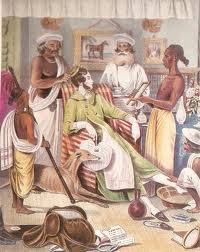British Colonization
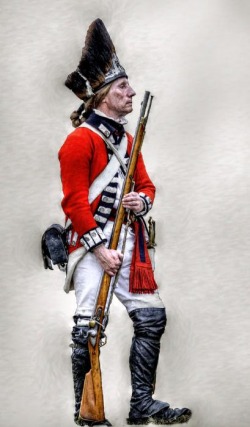
The first trading center for the British East India Company was stationed at Surat, Gujarat in 1612. In 1640, the British opened a second center in Madras and in 1687, the British main trading center changed from Surat to Bombay. The British started to get involved with local chieftains and princely states, which was when they started their spheres of influence in India. In 1690, the British established their base in Calcutta. Their first major action in India was when they supported Mir Kasim (Minister of Bengal) and collaborated with him to sabotage Siraj- ud- Daula, the Nawab. Robert Clive’s troops combined with Mir Kasim in a Battle of Plassey on June 23, 1757 to defeat the Nawab. This was when the British started getting involved in the politics and in the administration of India.
The British had a number of victories on the battlefield. They defeated Shah Alam who was a Mughal Emperor in 1764 in the battle of Baxar in Bihar. The Anglo- Mysore battles (1766-99) and Anglo- Maratha Battles (1722-1818), were battle that showed the world that the British were capable of expanding territory in India. The British also managed to gain control of the princely states through direct annexation or by giving military support. Other places such as: Punjab, Kashmir, and the North West Frontier Province (Pakistan) were either given to them or were captured by the British. The British annexed a number of places in India including: Sattara (1848), Udaypur (1852), Jhansi (1853), Tanjore (1853), Nagpur (1854), and Oudh (1856) all under the same excuse, that there was no legitimate heir able to rule.
Some people claim that the British East India Company’s cruelties and evil actions caused Indians to hate, and despise them and caused many revolts in India. Revolts in India at that time were surprisingly abrupt and they were unprepared on the Indian side. Examples of revolts: Sannyasi Revolt (1763-1800), Zemindar Revolt of Orissa (1804- 1817), The Resistance Rebellion of Tamil Nadu (1790-1805), and much more rebellions or revolts in India over the British. These revolts and rebellions influenced a movement called ‘the First Struggle for Independence’ (1857). The First Struggle for Independence in 1857 caused the end of the British East India Company.
The British had a number of victories on the battlefield. They defeated Shah Alam who was a Mughal Emperor in 1764 in the battle of Baxar in Bihar. The Anglo- Mysore battles (1766-99) and Anglo- Maratha Battles (1722-1818), were battle that showed the world that the British were capable of expanding territory in India. The British also managed to gain control of the princely states through direct annexation or by giving military support. Other places such as: Punjab, Kashmir, and the North West Frontier Province (Pakistan) were either given to them or were captured by the British. The British annexed a number of places in India including: Sattara (1848), Udaypur (1852), Jhansi (1853), Tanjore (1853), Nagpur (1854), and Oudh (1856) all under the same excuse, that there was no legitimate heir able to rule.
Some people claim that the British East India Company’s cruelties and evil actions caused Indians to hate, and despise them and caused many revolts in India. Revolts in India at that time were surprisingly abrupt and they were unprepared on the Indian side. Examples of revolts: Sannyasi Revolt (1763-1800), Zemindar Revolt of Orissa (1804- 1817), The Resistance Rebellion of Tamil Nadu (1790-1805), and much more rebellions or revolts in India over the British. These revolts and rebellions influenced a movement called ‘the First Struggle for Independence’ (1857). The First Struggle for Independence in 1857 caused the end of the British East India Company.
Blabberize
British in Control of India
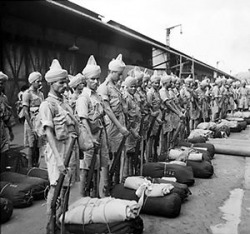
The First Struggle for Independence marked the end of the British East India Company it also marked the start of Queen Victoria of England taking over power in England. India became property of India from 1857 until 1947. In 1877, Queen Victoria became known as the Empress of India. Britain not only controlled India but also Pakistan, Myanmar, and Bangladesh. Unfortunately, in 1937, Myanmar was made a separate colony.
The British Raj had two different kinds of rule on lands- under direct rule and princely states that were controlled by Britain through agreements. After World War I Britain introduced reforms to control the Indians who were angry at the British Empire. The British also shared civil service and administration with Indians. The Code of 1837 was created for outline and give guidelines for laws in India. Although the British used these reforms to contain the Indians, this did not change the Indian view of the British.
The British Raj had two different kinds of rule on lands- under direct rule and princely states that were controlled by Britain through agreements. After World War I Britain introduced reforms to control the Indians who were angry at the British Empire. The British also shared civil service and administration with Indians. The Code of 1837 was created for outline and give guidelines for laws in India. Although the British used these reforms to contain the Indians, this did not change the Indian view of the British.
Above:
Picture 1: Indians in the Indian army during British Colonization
Picture 2: Servants taking care of a British Raj
Picture 1: Indians in the Indian army during British Colonization
Picture 2: Servants taking care of a British Raj
Abolishment of Sati (1829)
Sati- The practice of a widow who’s husband had died commits suicide (which was considered moral)The women who committed Sati were considered as Goddesses and sometimes had temples built in their memory. Sati was popular among Hindu women although not many Indian women in general committed Sati. Those women who committed Sati had Maha Sati stones (hero stones) that were built in their memory. Indian people believed wives who are truly in love with their husbands would commit Sati when their husbands die to be with them in the after life. The Indian leader Rajaram Mohan Roy of Brahmo Samaj was the first activist group to attempt to eliminate Sati. The British Government officially banned it in 1829. Throughout all of this Mahatma Gandi did not support this practice.
Indian National Congress (1885)
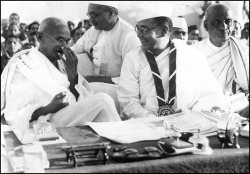
Gopalakrishna Gokhale, Lala Lajpat Rai, Gandhi, and Bose were leaders of the Indian National Congress (INC).The Nehru and Gandhi families are the ones who led the INC. Sir Allen Octavian Hume founded the Indian National Union which became the Indian National Congress. The INC marked the entry of the new educated middle- class.Viceroy Curzon is an arrogant and ambitious bureaucrat divided Bengal into two reducing the size and the population was also reduced. Curzon served as India’s viceroy (1899- 1905) and it was his decision to partition Bengal that only led to many complications, but in the end only brought the Bengalis and rest of Indians together. Viceroy Minto succeeded Curzon, he was a complex and violent man who wanted political reforms in India. He was mainly violent against Indians and Congressmen. In 1906, police in Barisol arrested INC delegates. In 1919, a British General fired on a peaceful protest rally in Jallianwala Bagh. After these incidents, revolutionary leaders rose to the scene and wanted the British dead or out of India, influential leaders such as: Bal Gangadhar Tilak, Subhas Chandra Bose, and Lala Lajpat Rai. Mohandas Gandhi entry into the INC marked the turning point in the INC and made a huge impact on history. Gandhi believed in non- violent protesting and made it a strict rule that he would not allow violence when he was the leader. He appealed to Indians who were religious with his concept of Satyagraha. Every time a disturbing incident happened he stop his actions, fasted (sometimes for several days) and prayed for peace, every time he was successful and the Indians stopped being violent.The INC feared getting involved in WWII and were tired of British rule in their home land, so they launched the Quit India Movement in 1942. Gandhi said to the British “ a few thousand British cannot control or govern millions of Indians.” An election in England that was held after the war, elected a government that was for Indian freedom so therefore India won it’s independence. Throughout all of this, the Indians had to battle the hatred between Hindus and Muslims. To resolve this conflict Pakistan was divided from India for Muslims and India for Hindus.
The Dandhi March (1930)
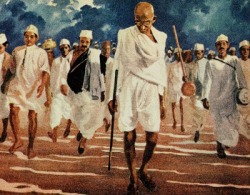
In April of 1930, a 61- year old man by the name of Mahatma Gandhi took on a long march to defy the law made by the British Empire. Gandhi reached Dandhi after walking 241 miles for 24 days and he defied the British law of making salt. This act that was peaceful in nature but only broke a minor law forced the British ponder on their decision whether to arrest him or not. In the end, the British chose not to arrest him but arrested millions other Indians who buying or selling salt. This showed how powerful a 61 year- old man can be with the influence he has over people.

